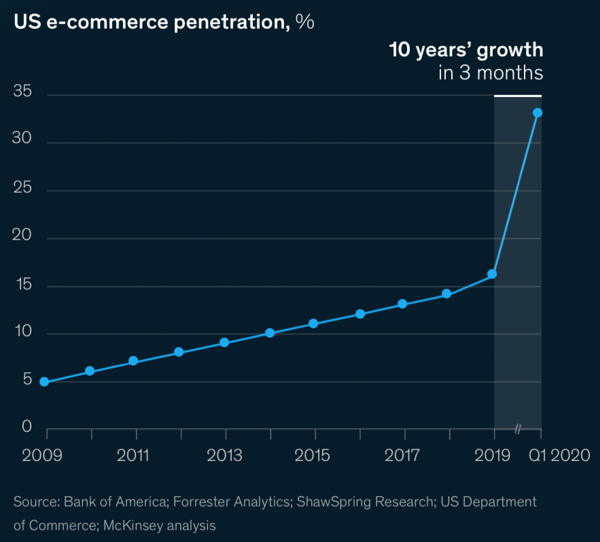Intershop conducted a webinar, "Creating a Digital B2B Strategy for Growth and Customer Loyalty", featuring Tobias Giese, Global VP Digital Solutions from Intershop and our guest Joe Cicman, Senior Analyst from Forrester.
In short, this webinar covered what B2B organizations should consider when building a digital B2B strategy, the benefits, and choosing the right technology that suits your organization’s digital maturity.
In 2020, the US industry went through 10 years of e-commerce growth in just the first three months of the pandemic. As a result, more consumers and business buyers are turning to e-commerce and experiencing how good or bad brands deliver on digital.

Source: McKinsey cited Forrester data
Source: "Five Fifty: The quickening," McKinsey & Company
Digital customer experience matters. Firms are being measured not just against competitors but every digital experience that customers or prospects encounter.
Here are our six key takeaways from the webinar:
- Digital is not only for millennials
- Omnichannel strategy is the best of both online and offline
- Good customer experience leads to loyalty
- Build your team before you build your apps
- Debunking the traditional build vs. buy decision making process assumptions
- Finding the right technology for your business
1. Digital is not only for millennials
Forrester data shows that 73% of millennials in the workforce are involved in purchasing decisions. Still, we also see the shift in baby boomers. Some are designing and ordering a car online without ever visiting a dealer's showroom. Generational preference seems irrelevant when it comes to the increasing number of buyers who prefer consumer-grade digital experiences.
The expectations are placed on the business to provide the digital experiences they need and be there in person for them. Consumers still have complex problems, and they need experts to help them identify the right solution.
The most recent Forrester survey finds that of all B2B sales:
- 42% go through a sales rep because many products are not fit for pure digital selling, and buyers have complicated pain points that require complex solutions.
- 24% go through a combination of rep assisted and self-service e-commerce.
- 18% of B2B technology buyers already make their initial purchase through a digital channel.
Joe believes that these ratios depend on a company’s product portfolio. Specifically, how much of their portfolio can be sold via self-service, rep-assisted digital commerce, and digitally enabled selling.
2. Omnichannel strategy is the best of both online and offline
Segment your product portfolio into low to high complexity
Most product-based businesses offer a range of products that address a range of business problems. Segment your product portfolio into low to high complexity. For example, if one field technician can easily buy a replacement part, the product is considered low complexity.
Understand that your buyer's process may be complex
On the other hand, your buyer needs support from peers and approval from the upline manager, then the go-ahead from a governance committee. In this case, the buyer's purchase process is considered high complexity.
Anticipating customer's needs
Overlaying your product portfolio over the buyer's purchase process from low to high complexity will tell you the ratio you can expect for your business when conducting user research and customer journey design.
Read more about the three digital strategies that every B2B firm should include in their playbook.
3. Good customer experience leads to loyalty
Getting the customer experience right leads to loyalty (retention, enrichment, and advocacy), leading to business growth. Getting the customer experience wrong translates to pain not only for you but for your customers as well. Friction leads to mistakes, delays, and decreased purchase confidence, and that erodes loyalty.
"B2B e-commerce is not a hobby for buyers. It's often mission-critical. Jobs can be on the line."
4. Build your team before you build your apps
Is digital (and what you do with it) something completely foreign?
Does it erase the human element? No – in fact – when done right it can amplify that deep expertise.
Joe thinks this quote sums it up nicely: "The best enterprise marketing today is embracing digital at scale to do what great salespeople have always done — personalize their engagement and offer a great experience”
Simply put, humans are an integral part of excellent customer delivery. Therefore, companies should invest in three areas to ensure digital transformation success:
- Hire experienced e-commerce experts with a background in consumer e-commerce. They will bring the sensibility of what you need to do in the primary research to determine what your buyers want and whether you're delivering on it.
- Invest in adopting design thinking and integrate those practices into how the business imagines, validates, and delivers digital experiences throughout the customer journey.
- Build on a robust and adaptable platform. Digital first go-to-market strategies require new operating models. This is what future-fit manufacturers are now incorporating into their business.
The commerce transaction is just one of many possibilities the business will build into the digital customer experiences. Most of your transactions are likely to happen with existing customers that use your products and engage with your business over time. When customers use digital to engage with your business, you will learn more about them, which helps you personalize how they discover and explore more of your products.
"Selling replacement parts through e-commerce is just the beginning of what you can do."
You can optimize all stages of your customer's life cycle when you digitize and automate all the channels your customers use.
5. Debunking assumptions about the traditional build vs. buy decision making process
Let's start with four flawed assumptions about software that impede their ability to adequately address their firm's customer experiences and operations.
Assumption 1 - the complexity & cost of packaged solutions
Leaders wrongly underestimate the complexity and cost of packaged solutions, so the traditional wisdom says that package solutions, including software-as-a-service (SaaS), are the least risky choice in terms of being secure, reliable and upgradable. The reality is that vanilla rarely exists. Some work in the form of customization and integration is almost always required to deliver solutions.
Assumption 2 - the cost and complexity of new app development
While the complexity and cost of packaged solutions are underestimated, technology leaders also wrongly overestimate the cost and complexity of new app development. The traditional wisdom says that building bespoke software is prohibitively risky and expensive. Still, the reality is that cloud platforms, API service catalogs, low-code platforms and modern development practices make custom development a practical, less risky and cost-effective option.
Assumption 3 - the value of platform and ecosystems
Technology leaders wrongly underestimate the value of platforms and ecosystems. The traditional wisdom says buy or build the optimal solution for a given business problem. Still, the result, particularly in the SaaS area, is companies managing hundreds or thousands of discrete business solutions, which the human API often integrates. The robust ecosystem that supports acquiring and building solutions on common platforms serve better common platforms, eliminating redundant technical work, reducing the cost and complexity of integration between individual apps, and promoting overall application security and stability.
Assumption 4 - most businesses are unique
Technology leaders wrongly overestimate how similar companies are, so the future of the traditional wisdom says that build rarely and for the few pieces of software that differentiate and buy the rest of the software your firm needs and assume there's little that's unique about your business. Still, the reality is that every company has mountains of paper and excel based workarounds instead of custom software.
6. Finding the right technology for your business
When we look at Forrester's research on the e-commerce vendor offerings, we find that suites with all-in-one packages are the best fit for businesses early in their digital transformation.
Why? Because those businesses rarely have hundreds of modern cloud-native developers in modern suites pre-integrate their own and their partners' components so that you can focus on a post-pandemic world and devote your attention to realign for the current times.
Additional resources on choosing the right technology:
- Watch this webinar on replatforming and how to select the right e-commerce technology that will scale as your business grows.
- Read the report: "The State of International E-commerce in Manufacturing" to learn where global manufacturers are investing and common challenges in digitalization.
The opportunity for digital experience isn't optional anymore. It's the only way forward.







